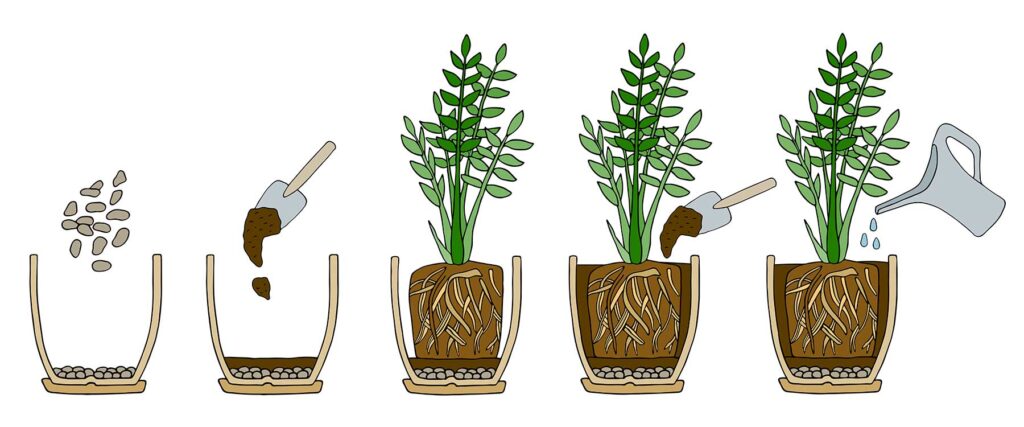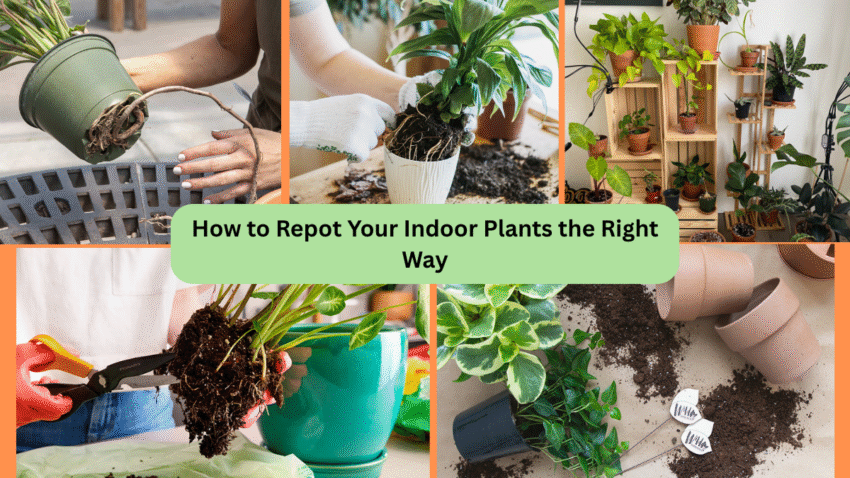Repotting a plant is an important skill for every home gardener. Over time, plants outgrow their pots and need fresh soil and more space. This process helps them stay healthy, grow better, and live longer. In India, where many people grow plants in balconies, terraces, and small indoor spaces, repotting becomes even more essential.
In this article, we will discuss how to repot plants correctly, the tools you need, the right timing, and common mistakes to avoid. Whether you grow indoor plants, balcony plants, or container gardens, these tips will help your plants thrive.
Why Repotting Plants Is Important

Repotting is not just about giving a plant a bigger home. It’s about creating better conditions for healthy growth.
Benefits of repotting:
- Gives roots more space to grow
- Refreshes old, nutrient-depleted soil
- Prevents root rot and disease
- Improves water drainage
- Encourages healthier and faster growth
If your plant has been in the same pot for years, it might be struggling without you even realizing it.
Signs Your Plant Needs Repotting

You should not repot plants too often, but there are clear signs when it’s time:
- Roots are coming out from the drainage holes.
- Water drains out too quickly after watering.
- Soil is compact and hard.
- Leaves are turning yellow without any other reason.
- The plant has stopped growing or is growing very slowly.
Also Read Never Run Low: Easy Tips to Avoid Common Nutrient Deficiencies in Indian Diets
Best Time to Repot Plants in India
For most plants in India, spring (February–April) and monsoon (July–September) are the best times. This is when plants are actively growing and can recover quickly. Avoid repotting during extreme heat or peak winter.
Tools and Materials You Will Need
Before you start, keep these handy:
- A new pot (1–2 inches larger than the current one)
- Fresh potting mix (choose based on plant type)
- Gardening gloves
- A small trowel or spade
- Watering can
- Cocopeat or compost for soil enrichment
Step-by-Step Guide to Repotting a Plant
1. Choose the Right Pot
Pick a pot that is slightly bigger than the current one. Too large a pot can cause excess water retention, leading to root rot. Make sure it has drainage holes.
2. Prepare the Potting Mix
For Indian conditions, a good general mix can be:
- 40% garden soil
- 30% compost or vermicompost
- 20% cocopeat for moisture retention
- 10% sand for drainage
3. Water the Plant Before Repotting
Watering a day before makes it easier to remove the plant from the pot without damaging the roots.
4. Gently Remove the Plant
Hold the base of the stem and tilt the pot. Tap the sides to loosen the soil and slide the plant out. Be gentle with the roots.
5. Loosen the Roots
If the roots are tangled, gently tease them apart with your fingers. Trim any dead or rotten roots with clean scissors.
6. Add Soil to the New Pot
Place a layer of soil at the bottom of the new pot. Position the plant in the center. Fill the sides with fresh potting mix, pressing gently to remove air pockets.
7. Water and Place in Indirect Light
After repotting, water the plant lightly and keep it in indirect sunlight for a few days to recover.
Common Mistakes to Avoid While Repotting
- Using a pot that’s too big
- Overwatering after repotting
- Repotting during extreme weather
- Damaging roots during removal
- Forgetting to add drainage holes
Tips for Healthy Plants After Repotting
- Avoid fertilizing for the first 2–3 weeks.
- Keep the soil slightly moist but not soggy.
- Gradually expose the plant to its usual light conditions.
- Monitor leaves for signs of stress.
FAQs on Repotting Plants
1. How often should I repot my plants?
Most plants need repotting every 1–2 years, but slow-growing plants may last longer in the same pot.
2. Can I reuse old soil?
It’s better to refresh the soil with compost and cocopeat before reusing it to avoid nutrient depletion.
3. Should I prune the plant while repotting?
Light pruning is fine, especially for damaged or dead leaves. Avoid heavy pruning at the same time as repotting.
4. What’s the best pot for indoor plants?
Terracotta and ceramic pots work well as they allow better air circulation for roots.
Final Thoughts
Repotting is an essential gardening skill for anyone growing indoor plants, balcony gardens, or container plants in India. It may seem tricky at first, but once you follow the right steps, your plants will grow healthier and more beautiful. With the right pot, fresh soil, and gentle care, you can give your plants a fresh start and a better life.
Author- Ayush
